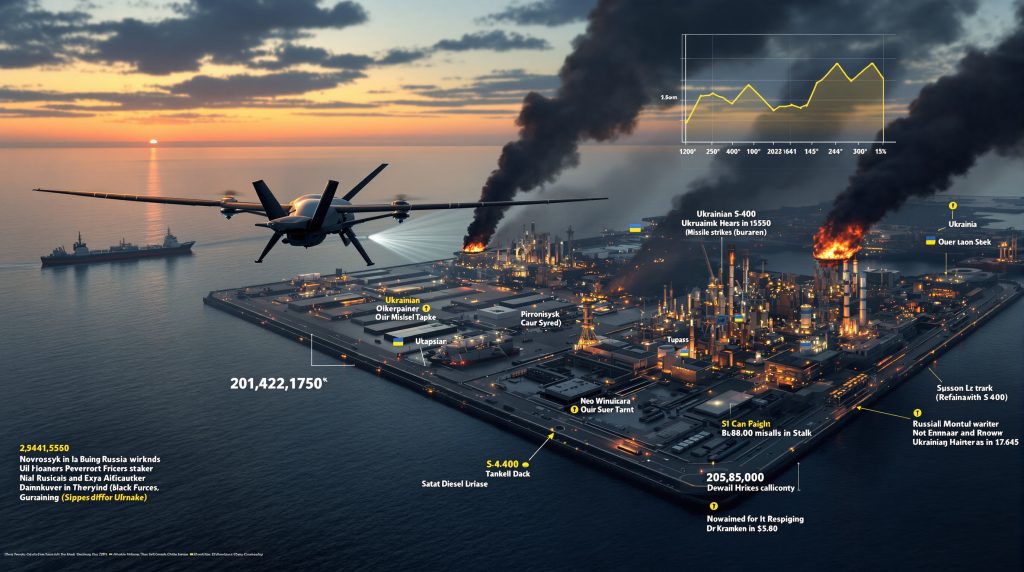The Strategic Landscape of Ukrainian Drone Strikes on Russian Oil Infrastructure
Ukrainian forces have strategically targeted key components of Russia's oil export infrastructure, focusing on vital maritime terminals, refineries, and logistics hubs. These precision strikes aim to disrupt Russia's ability to export crude oil and refined products, creating significant economic pressure through multiple points of vulnerability.
- Black Sea oil terminals serving as critical export gateways
- Major refineries processing crude into higher-value products
- Loading facilities and storage depots essential for export operations
- Pipeline infrastructure connecting production to export points
The targeting pattern reveals a sophisticated approach focused on maximizing economic impact while minimizing civilian casualties through precise drone deployment against high-value energy assets. Analysis suggests these operations are designed to create maximum disruption with minimal resources, exploiting Russia's widespread and vulnerable energy infrastructure.
How Drone Strikes Affected Russia's Novorossiysk Oil Hub
The September 2025 drone attacks on Novorossiysk created substantial disruption to one of Russia's most critical oil export centers. This strategic Black Sea port houses multiple high-value targets that were successfully struck, resulting in temporary but significant operational impacts.
Key Facilities Impacted
-
Caspian Pipeline Consortium (CPC) Terminal
- Handles 1.3 million barrels daily (primarily Kazakh crude)
- Office facilities damaged in the September 24th attack
- Operations temporarily suspended for safety assessments
- Loading operations resumed within 24 hours but with reduced capacity
-
Transneft's Sheskharis Complex
- Primary export facility for Russian Urals crude blend
- Loading pier infrastructure damaged
- Forced temporary suspension of tanker operations
- Created immediate scheduling disruptions for Mediterranean-bound shipments
The combined impact temporarily removed approximately 2-2.5 million barrels per day of export capacity from global markets, triggering immediate price sensitivity in Mediterranean crude markets. According to OilPrice.com analysis, "even short suspensions at Novorossiysk can push up freight rates and alter tanker schedules," highlighting the strategic importance of this export hub.
Damage Assessment at the Tuapse Oil Terminal
The Ukrainian maritime drone strike on Tuapse represented a significant blow to another vital Russian Black Sea export facility, creating operational challenges that extended beyond the immediate damage.
Extent of Damage
- Oil loading pier infrastructure suffered direct hits
- Marine loading arms critical for tanker filling operations damaged
- Control systems for loading operations compromised
- Pipeline connections to storage facilities affected
Operational Impact
- Complete suspension of loading operations for 48+ hours
- Reduced throughput capacity even after partial resumption
- Tanker scheduling disruptions affecting multiple cargoes
- Rerouting requirements for vessels already en route
The Tuapse facility typically handles approximately 240,000 barrels per day of exports, primarily serving Mediterranean and Asian markets. Its strategic importance is magnified by limited alternative export routes for southern Russian production, making this disruption particularly effective in terms of export capability reduction.
Ukraine's Comprehensive Campaign Against Russian Refineries
Ukraine has executed a methodical campaign targeting Russian refining capacity across multiple regions, with attacks extending deep into Russian territory. Recent targets mentioned in reports include facilities in Ryazan and Astrakhan, as well as fuel storage depots in Krasnodar and Belgorod regions.
Major Refinery Targets
| Refinery Location | Distance from Ukraine | Capacity Affected | Status After Attack |
|---|---|---|---|
| Kirishi (Leningrad) | 900+ km | 420,000 bpd | Partial operation |
| Salavat (Bashkortostan) | 1,400+ km | 380,000 bpd | Significant downtime |
| Ryazan | 500+ km | 340,000 bpd | Reduced throughput |
| Astrakhan | 800+ km | 200,000 bpd | Temporary shutdown |
| Krasnodar | 300+ km | 160,000 bpd | Damaged processing units |
Cumulative Impact
- Over 1 million barrels per day of refining capacity affected
- Diesel production particularly impacted (down 40% from pre-attack levels)
- Forced Russia to reconfigure domestic fuel distribution networks
- Created localized fuel shortages in southern Russian regions
The campaign demonstrates Ukraine's ability to penetrate deep into Russian airspace with unmanned systems, challenging Moscow's air defense capabilities and creating significant economic pressure. According to sources, "Russia is being forced to divert air defences to protect refineries and ports," indicating the strain these attacks are placing on Russian military resources.
Economic Consequences for Russia
The systematic targeting of Russia's oil infrastructure has generated cascading economic effects beyond the immediate physical damage, affecting both export revenues and domestic energy markets.
Direct Financial Impacts
- Reduced export revenue from lower crude and product shipments
- Increased insurance premiums for tankers loading at targeted ports
- Higher maintenance and repair costs for damaged facilities
- Capital expenditure requirements for hardening vulnerable infrastructure
Market Disruptions
- Diesel exports fell to 5-year lows (down approximately 65% from pre-attack levels)
- Urals crude differential widened by $1.50-2.00 per barrel on supply concerns
- Freight rates increased for Black Sea loadings due to risk premiums
- Domestic fuel price pressures in regions affected by refinery outages
Long-Term Implications
- Potential permanent loss of certain export markets as buyers seek alternatives
- Accelerated shift of Russian exports eastward to less vulnerable ports
- Increased operational costs due to security enhancements and insurance
- Pressure on government finances during a period of US economic pressures
The cumulative effect represents a significant strain on Russia's energy-dependent economy, with export revenues declining at a critical juncture. Bloomberg analysis cited in reports notes that "repeated disruptions could push differentials for Urals and CPC Blend higher," suggesting ongoing market impacts from the campaign.
Russia's Defensive Response to Protect Oil Infrastructure
Moscow has implemented a multi-faceted defensive strategy to mitigate the impact of continued drone strikes on Russian oil terminals, balancing military and operational adaptations.
Enhanced Security Measures
- Expanded air defense coverage around critical energy infrastructure
- Redeployment of advanced systems like S-400 and Pantsir-S1 to protect refineries
- Electronic warfare capabilities to disrupt drone navigation systems
- Physical hardening of vulnerable infrastructure components
- Increased maritime patrols in Black Sea export corridors
Operational Adaptations
- Adjusted loading schedules to minimize predictable patterns
- Dispersed storage of petroleum products to reduce concentrated targets
- Nighttime blackout protocols at major facilities
- Rapid repair capabilities pre-positioned at critical infrastructure
- Alternative export routing development to reduce dependence on vulnerable terminals
Despite these measures, the drone campaign has demonstrated the inherent vulnerability of fixed infrastructure against asymmetric threats, forcing Russia to accept certain operational limitations. Russia has also responded with countermeasures, including "additional strikes on Ukrainian power infrastructure, including substations in Chernihiv and Poltava," according to Reuters reporting.
Global Oil Market Reactions
The market response to Ukraine's strategic targeting of Russian oil infrastructure has been nuanced but significant, with varying impacts across different regions and market segments.
Price Impacts
- Short-term price spikes following major terminal attacks (typically $2-3 per barrel)
- Widened regional differentials for Mediterranean refiners dependent on Black Sea supplies
- Increased volatility in diesel and fuel oil markets where Russian exports dominate
- Risk premiums embedded in forward pricing for Russian export grades
Supply Chain Adjustments
- Mediterranean refiners seeking alternative crude sources from North Africa and Middle East
- Asian buyers negotiating increased volumes from Middle Eastern producers
- European storage operators building precautionary inventories of middle distillates
- Trading houses developing alternative supply routes for formerly Russian-supplied markets
The market has demonstrated resilience through rapid adaptation, but the persistent nature of the campaign has created structural changes in regional trade flows and pricing relationships. As of September 25, 2025, Brent crude was trading at $69.02 per barrel, WTI at $64.64, and Murban crude at $70.39, with market participants closely monitoring the situation for further disruptions amid continued commodity market volatility.
Defensive Vulnerabilities Exposed
The Ukrainian drone campaign has revealed significant gaps in Russia's ability to protect its sprawling energy infrastructure, creating persistent security challenges.
Air Defense Limitations
- Coverage gaps between defensive systems protecting urban centers versus industrial facilities
- Detection challenges against low-flying, small-signature maritime drones
- Resource constraints forcing prioritization of military versus economic targets
- Coordination weaknesses between different branches of air defense forces
Infrastructure Vulnerabilities
- Concentrated export facilities creating single points of failure
- Exposed loading equipment particularly vulnerable to precision strikes
- Limited redundancy in certain export corridors
- Aging infrastructure at some facilities complicating rapid repairs
These vulnerabilities suggest a fundamental asymmetric advantage for drone warfare against fixed energy infrastructure, creating a persistent challenge for Russian defensive planners. The requirement to disperse air defense assets across a vast territory has created inevitable weak points that Ukrainian forces continue to exploit.
Evolution of Ukrainian Drone Capabilities
Ukraine has demonstrated increasingly sophisticated drone capabilities throughout its campaign against Russian oil infrastructure, with technical and tactical improvements evident in each successive operation.
Technical Advancements
- Extended operational range enabling strikes deeper into Russian territory
- Improved payload precision allowing targeting of specific infrastructure components
- Enhanced stealth characteristics reducing detection probabilities
- Greater autonomy reducing vulnerability to electronic countermeasures
- Swarm coordination enabling simultaneous multi-point attacks
Tactical Innovations
- Diversified approach vectors to confuse defensive responses
- Combined air and maritime drone operations in coordinated strikes
- Decoy deployments to exhaust defensive resources
- Weather-optimized mission planning to exploit conditions unfavorable to air defenses
- Rapid adaptation to evolving Russian countermeasures
These evolving capabilities suggest Ukraine's drone campaign may continue to present significant challenges to Russian energy infrastructure despite defensive adaptations. The continued refinement of these capabilities points to an ongoing strategic commitment to targeting Russia's energy export sector.
Implications for Global Energy Security
The Ukrainian drone campaign against Russian oil infrastructure carries broader implications for global energy security, potentially reshaping how vulnerable energy systems are protected worldwide.
Near-Term Considerations
- Increased price volatility in specific product markets (particularly diesel)
- Regional supply disruptions for countries heavily dependent on Russian exports
- Higher transportation costs due to security premiums and rerouting requirements
- Inventory building among concerned consumers creating temporary market tightness
Longer-Term Systemic Changes
- Accelerated diversification away from Russian energy supplies in vulnerable markets
- Increased infrastructure hardening investments globally as lessons are applied elsewhere
- Insurance market adjustments for energy facilities in conflict-adjacent regions
- Renewed focus on strategic reserves as buffer against similar disruptions
Strategic Reassessments
- Energy infrastructure vulnerability now more prominently featured in security planning
- Drone defense capabilities becoming critical component of energy security
- Supply chain resilience receiving greater investment priority
- Geopolitical risk premiums potentially becoming more permanent in certain regions
The campaign demonstrates how asymmetric warfare capabilities can effectively target energy infrastructure, potentially reshaping how energy security challenges are conceptualized globally. Industry analysts suggest this may lead to fundamental reconsiderations of how critical energy assets are protected in future conflicts.
Future Campaign Evolution
Based on current patterns and capabilities, several potential developments may shape the future of Ukraine's campaign against Russian oil infrastructure in the coming months.
Potential Escalation Pathways
- Targeting of eastern export facilities to disrupt alternative export routes
- Coordinated strikes against multiple facilities simultaneously to overwhelm defenses
- Secondary targeting of repair capabilities to extend facility downtime
- Expansion to natural gas infrastructure targeting LNG facilities and processing plants
Limiting Factors
- Drone production constraints potentially limiting operational tempo
- Seasonal weather considerations affecting maritime drone effectiveness
- Russian adaptive countermeasures potentially reducing strike effectiveness
- International pressure regarding potential environmental impacts of attacks
Key Indicators to Watch
- Geographic expansion of targeting beyond current focus areas
- Technical sophistication of future drone systems deployed
- Russian defensive investments indicating anticipated threat evolution
- Market preparation through inventory building and contract adjustments
The dynamic nature of this campaign suggests continued adaptation on both sides, with significant implications for Russian export capabilities and global energy markets through 2026. Market participants are closely monitoring developments for signs of escalation or adaptation from either side, particularly as the continuing oil price rally could be affected by disruptions.
Frequently Asked Questions
How have drone strikes affected global oil prices?
While global benchmark prices have shown limited sustained movement, regional differentials have widened significantly. Mediterranean refiners previously dependent on Black Sea supplies have faced premiums of $1-3 per barrel for alternative crudes, while diesel markets have experienced more pronounced volatility with price spikes of 8-12% following major refinery strikes. Current oil prices as of September 2025 show Brent trading at $69.02 per barrel and WTI at $64.64.
Are these drone strikes causing environmental damage?
Limited environmental impacts have been reported thus far. Most strikes have targeted loading equipment rather than storage tanks, minimizing oil spills. Russian authorities have reported localized contamination at several sites, but independent verification remains challenging. International environmental monitoring organizations continue to assess potential Black Sea impacts, particularly concerning maritime drone strikes near coastal facilities.
How effective are Russia's air defenses against these drones?
Russian air defenses have shown mixed effectiveness. While claiming interception rates of 70-80%, visual evidence and operational disruptions suggest significantly lower success rates against maritime drones in particular. Defense systems optimized for conventional aircraft struggle with small, low-flying targets, especially in complex coastal environments. The need to protect such extensive infrastructure has stretched defensive capabilities.
Could these attacks lead to wider regional escalation?
The targeted nature of the campaign against economic infrastructure rather than civilian targets has thus far contained escalation risks. However, Russian officials have increasingly characterized the strikes as attacks on critical national infrastructure that warrant proportional response, raising concerns about potential counter-escalation against Ukrainian energy facilities. The situation remains dynamic as both sides calibrate their operations.
How are European refiners adapting to these supply disruptions?
European refiners previously dependent on Russian supplies have implemented several adaptation strategies: diversifying crude sources to North African and Middle Eastern suppliers, adjusting refinery configurations to process different crude slates, building larger precautionary inventories, and in some cases, reducing utilization rates during periods of acute supply uncertainty. This has created a more resilient but higher-cost operating environment with associated tariff market impacts.
Further Exploration
Readers interested in learning more about the geopolitical dynamics of energy infrastructure targeting can also explore related educational content available from OilPrice.com, which offers additional perspectives on global energy security challenges and market impacts of regional conflicts. The evolving nature of this campaign continues to reshape understanding of energy security in conflict zones.
Disclaimer: This analysis is based on information available as of September 2025 and reflects the ongoing nature of the conflict. Market conditions, military operations, and political developments may significantly alter the situation described above.
Want to Catch the Next Major Mining Discovery Before the Market?
Discovery Alert's proprietary Discovery IQ model instantly notifies investors of significant ASX mineral discoveries, transforming complex geological data into actionable trading insights ahead of the broader market. Explore why these discoveries can generate substantial returns by visiting Discovery Alert's dedicated discoveries page and begin your 30-day free trial today.




